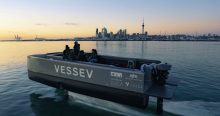 Vessev, a global leader in sustainable marine technology revealed the VS-9 which will unlock entirely new opportunities for premium passenger transport on the water. By partnering with Fullers360, New Zealand’s largest ferry operator, the VS-9 will become the first fully electric passenger vessel to operate in Auckland and the first hydrofoiling tourism vessel to operate in the world. NetZero Maritime, Fullers360’s specialist maritime green technology and innovation team, has played a pivotal role in the adoption of this new type of vessel.
Vessev, a global leader in sustainable marine technology revealed the VS-9 which will unlock entirely new opportunities for premium passenger transport on the water. By partnering with Fullers360, New Zealand’s largest ferry operator, the VS-9 will become the first fully electric passenger vessel to operate in Auckland and the first hydrofoiling tourism vessel to operate in the world. NetZero Maritime, Fullers360’s specialist maritime green technology and innovation team, has played a pivotal role in the adoption of this new type of vessel.Designed and built by Vessev (formerly Seachange) the VS-9 delivers smooth and quiet travel on the water like never before. The state-of-the-art vessel is currently undergoing sea trials out of Auckland, New Zealand, and the first VS-9 will be certified this year, entering commercial operation with Fullers360 thereafter.
The nine-meter VS-9 will transport up to 10 passengers at a service speed of 25 knots providing an experience that is more like flying than sailing The VS-9 has a range of 50 nautical miles (57 miles/92.6km) thanks to state-of-the-art efficient hydrofoiling technology.
Eric Laakmann, Vessev CEO, said: “We are in the earliest stage of a global transition to sustainable energy use. Our partnership with NetZero Maritime is one of the most powerful in the world in accelerating the adoption of new technologies. There are 33 million vessels in the world today with sustainable vessels representing the smallest fraction. Through significant enhancements in efficiency, hydrofoiling will play a key role in this once-in-a-generation shift.
Vessev’s expert team of marine engineers and boat builders, combined with Fullers360’s NetZero Maritime decarbonization team, has ensured the VS-9 is designed and built to align seamlessly with commercial and tourism transport requirements.
“Our partnership integrates New Zealand’s largest ferry transport and tourism operator with one of the country’s foremost sustainable marine technology providers. At Vessev, our ethos of ‘engineered for safety’, ‘built to last’ and ‘impact through performance’ is vital, and that’s exactly what the VS-9 delivers”, added Laakmann.
Unlocking new opportunities
The VS-9 will unlock new opportunities on the water that haven’t been possible until now.
Laakmann commented: “Traditionally, larger vessels are required to deliver a comfortable passenger experience as they can handle the impact of waves and wake. By flying above the waves the VS—9 delivers a large vessel experience on an agile platform that can be berthed and charged in nearly any marina.
“The development and commercialization of the VS-9 unlocks entirely new possibilities on the water enabling a shift toward more efficient, more reliable and more comfortable marine transport. The VS-9 will enable thousands of new routes around the world that are currently impractical for traditional vessel.
“The costs of maintaining and fueling commercial fossil fuel vessels is quite substantial. We expect that in almost any commercial application, the lifetime cost of ownership of these vessels will be substantially less than comparable fossil fuel vessels. That is not including any additional revenue for operators which may come from operating vessels that deliver the best possible passenger experiences’.
Laakmann further commented: “The benefits of the VS-9 scale up to larger vessels. We are already working to develop the VS-18, a 100-passenger vessel using the same technology and design of the VS-9, which will have additional seakeeping capability and unlock even more opportunities”.
Incredibly efficient foiling technology
The VS-9 features ultra-high authority hydrofoil systems, where the foils change shape using high precision flaps under the water to optimize efficiency. This enables the VS-9 to handle adverse weather and provide far better seakeeping than other technologies. Vessev’s engineers used some of the same techniques employed by winning America’s Cup teams to make its systems ultra-efficient and resilient.
“To our knowledge, the VS-9 will be the only certified passenger electric hydrofoiling vessel to utilise this technology. We use techniques similar to America’s Cup vessels which provide very high control authority when compared to other systems. That means we can handle more wind and bigger seas. The system is more difficult to engineer up-front, but results in a very performant vessel that is both more capable and more efficient.” Says Laakmann.
“The VS-9 is so efficient that we are able to use very safe and longer lasting battery technologies when compared to other vessels of this type”.
Vessev’s technology reduces energy consumption by up to 95%, facilitating a range of up to 50 nautical miles at a service speed of 25 knots and significantly reduced operational costs. The energy efficiencies deliver much faster charging, more range and energy cost savings already evident after just two weeks of sea-trials.
“To put it into perspective, the VS-9 is undergoing on-water testing with a petrol-powered chase boat following, doing the same motions and distance. At the end of each day, the cost of the petrol fueling the chase boat is 25 times the cost of the electricity used to charge the VS-9”, explains Laakmann.
 Tourism Breaking News
Tourism Breaking News


